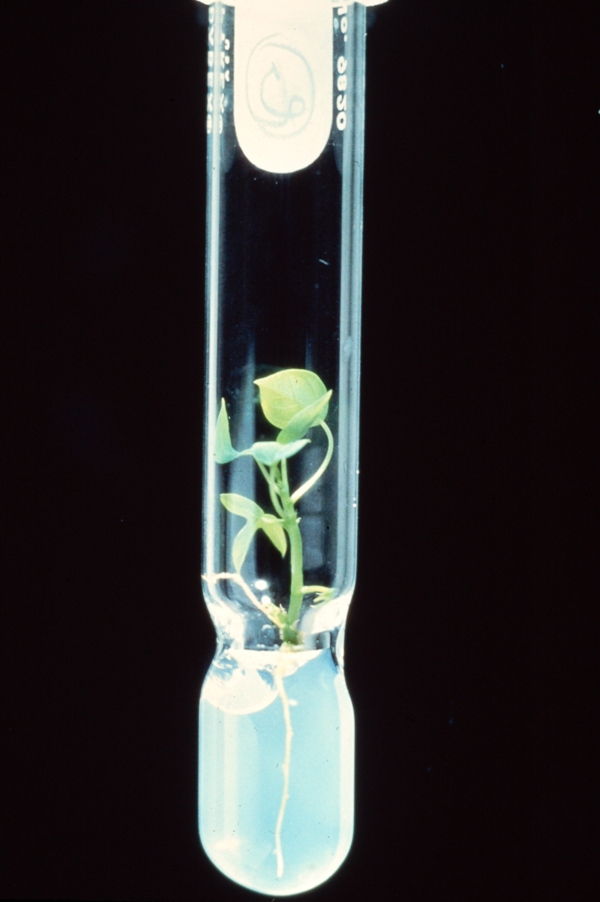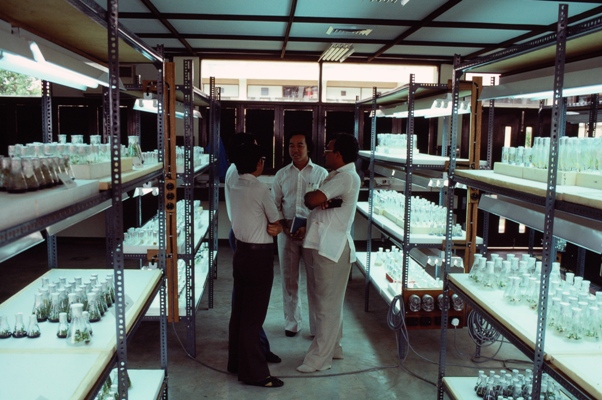In vitro conservation of cassava genetic resources
Contributors to this page: CIAT, Colombia (Daniel Debouck, Roosevelt Escobar, Graciela Mafla); IITA, Nigeria (Dominique Dumet, Badara Gueye); Bioversity International, France (Ines Van den Houwe, Bart Panis, Nicolas Roux); Bioversity International/ILRI, Ethiopia (Alexandra Jorge); INIA, Peru (Llerme Rios); independent consultants (Erica Benson, Keith Harding, Clair Hershey).
What is in vitro conservation
|
|
In vitro techniques have been increasingly used for plants in the last 40-50 years. Conservation of genebank accessions is only one of several uses for the techniques. The basic procedure consists of conserving parts of plants in flasks or tubes in artificial media, under controlled environments, normally in sterile conditions. A prerequisite of successful in vitro conservation is that the plants or plant parts can be regenerated into complete plants for growth and use in any of the ways that genetic resources are used. Conservation of cassava in vitro is normally under slow growth storage (SGS), in conditions of controlled light and temperature and growth retardant chemicals.
While cryopreservation for long-term storage (LTS) is also technically an in vitro technique, the procedures are quite different from slow growth in vitro procedures, and they are discussed in a separate section.
Where is it used
An increasing number of countries has invested in tissue culture laboratories since the 1980s, when the techniques became broadly applicable for the propagation of clonal crops, including cassava. International collections are held at CIAT and at IITA, while all other in vitro genebanks have a national or regional focus. Many of these laboratories combine goals for in vitro techniques for pathogen cleaning, rapid multiplication and gene bank conservation.
Ng and Ng (2002) reviewed the status of in vitro cassava genebanks around the world. While they noted 47 countries with genebanks, only 12 countries maintained in vitro genebanks. Since there has not been a comprehensive survey of cassava genebanks, this may not be a complete listing. Nonetheless, it does appear to indicate that in vitro conservation of cassava is still far less common than field conservation. The largest national in vitro collections are held in Brazil and Argentina. There appear to be very few in vitro genebanks in Africa.
When it should be used
|
|
In vitro techniques are used:
- To conserve vegetative plant parts of cassava germplasm.
- To conserve plantlets that result from embryo rescue of seeds, which may be especially useful for the wild Manihot species whose seeds are difficult to germinate.
- As a viable alternative to complement and reduce the large size required for field banks.
- To reduce space requirements and eliminate the possibility of losses due to edaphic and climatic factors, two of the major sources of losses in field genebanks.
- To duplicate field banks.
- To replace field banks.
- To allow national and international germplasm exchange.
- To assure more secure conservation of germplasm for future generations.
Costs (qualified labour, energy, supplies and infrastructure) are highly location-specific and economies of scale should be considered before the adoption of in vitro conservation.
If there are other functions that can be shared by the cassava in vitro laboratory and genebank, there will be considerable savings through more efficient use of space, labour, supplies and management. For example, the facilities could be used to conserve another crop (sweet potato, banana, potato, etc.) or for cleaning and multiplying new varieties for distribution after release.
How should it be done
- It requires specialized laboratories and equipment with very skilled technicians and researchers.
- It also requires adaptive technologies for some more difficult species.
- It requires sterile conditions and very well controlled artificial growth environments.
- It requires high initial investments but relatively low maintenance costs in a long-term perspective.
- In vitro conservation can be more efficient and cost-effective if the laboratory forms part of a conservation strategy also involving other crops.
- In vitro conservation may be more efficient and cost-effective if the laboratory forms part of a system that also works with in vitro techniques of pest or pathogen cleaning and rapid multiplication technique.
References and further reading
Calles T, Dulloo ME, Engels JMM, Van den Houwe I. 2003. Best Practices for Germplasm Management - A new approach for achieving genebank standards. Technical Report. International Plant Genetic Resources Institute, Global Crop Diversity Trust, Rome, Italy.
Cuervo MI, Balcazar MS, Ramirez JL, Medina CA, Debouck D. 2009. Manual de operaciones laboratorio sanidad de germoplasma – unidad de recursos genéticos. GRP, CIAT, Colômbia. 72 pp. Available in Spanish (2.8 MB) and English (2.6 MB).
Escobar RM, Roca WM, Mafla G, Roa J. 1994. In vitro conservation of genetic resources: the case of cassava. CIAT (Internal Circulation). 23 p.
Escobar R, Mafla G, Roca WM. 1993. Cryopreservation of cassava shoot tips. In: Roca WM, Thro AM, editors. Proceedings First Scientific meeting of the Cassava Biotechnology Network, 25-28 Aug. 1992, Cartagena. CIAT, Cali, Colombia. pp. 116-121.
Fregene M, Ospina JA, Roca W. 1999. Recovery of cassava (Manihot esculenta Crantz) plants from culture of immature zygotic embryos. Plant Cell Reports 55:39-43.
IITA. 2007. Cassava in vitro processing and gene banking. IITA Genebank series 2007. Available here .
Mafla G, Roa JC, Guevara CL. 2000. Advances on the in vitro growth control of cassava using silver nitrate. In: Carvalho LJCB, Thro AM, Vilarinhos AD, editors. Proceedings IV International Scientific meeting of the Cassava Biotechnology Network, Salvador, Bahia, Brazil. November 03-07, 1998. EMBRAPA , CENARGEN and CBN. Brasilia, Brazil. pp. 439-446.
Mafla G. 1994. Conservación de germoplasma in vitro. In: King C, Osorio J, Salazar L, editors. Memorias I Seminario Nacional sobre Biotecnología. Universidad del Tolima. Colombia. pp 65-77.
Mafla G. 1995. Manejo de datos e información de la colección in vitro de yuca (Manihot esculenta Crantz). In: Memorias. Curso en Documentación de Recursos Fitogenéticos. Auspiciado por Universidad Nacional de Colombia, Bioversity y CIAT. Palmira, pp. 97-118.
Mafla G, Roa JC, Aranzales E, Debouck D. 2009. Handbook of procedures for in vitro germplasm conservation of the genus Manihot. CIAT, Cali, Colombia. 56 pp. Available here (8 MB).
Mafla G, Roa JC, Flor NC, Debouck DG. 2002. Conservación in vitro y utilización del germoplasma del género Manihot. Trabajo presentado en el VIII Congreso Latinoamericano de Botánica y II Congreso Colombiano de Botánica, Cartagena, Colombia, 13-18 Octubre 2002. Available from: http://isa.ciat.cgiar.org/urg/urgweb_folder/files/posters/cartagenafinal.pdf. Date accessed: 26 August 2010.
Mafla G, Roa JC, Ocampo C, Gallego G, Jaramillo G, Debouck DG. 2004. Efficacy of silver nitrate for slow growth conservation of cassava (Manihot esculenta Crantz). Determination of viability and genetic stability. In: Abstracts of the Sixth International Scientific meeting of the Cassava Biotechnology Network. March 8-14 CIAT, Cali, Colombia. p. 134.
Mafla G, Roa JC, Ocampo CH, Gallego G, Jaramillo G, Debouck DG. 2004. Efficacy of silver nitrate for slow-growth conservation of cassava (Manihot esculenta Crantz). Determination of viability and genetic stability. Poster presented at CBN-IV. Available from: http://isa.ciat.cgiar.org/urg/urgweb_folder/files/posters/CBN-VI.pdf. Date accessed: 26 August 2010.
Mafla G, Roa JC, Roca WM. 1990. Micropropagación de la yuca para la producción de material de siembra libre de enfermedades. In: Jaramillo J, y Agudelo O, editors. La nueva Biotecnología. Fundamentos, usos y perspectivas. ICA. pp. 91-101.
Mafla G, Roca WM, Reyes R, Roa JC, Muñoz L, Baca AE, Iwanaga M. 1992. In vitro management of cassava germplasm at CIAT. In: Roca WM, Thro AM, editors. Proceedings of First International Scientific meeting of the Cassava Biotechnology Network. Cartagena, Colombia. pp. 168-174.
Ng, NQ, Ng SYC. 2002. Genetic resources and conservation. In: Hillocks RJ, Thresh JM, Bellotti A, editors. Cassava: Biology, Production and Utilization. CABI Publishing. pp. 167-177.
Roca WM, Angel F, Sarria R, Mafla G. 1992. Future initiatives in biotechnology research for tropical agriculture: the case of cassava. In: McCorwick DK, editor. Advances in Gene Technology: Feeding the World in the 21st Century, 1992 Miami Bio/technology Winter Symposium, Miami, FL, USA, pp. 87.
Roca WM, Chaves R, Marin ML, Arias DI, Mafla G, Reyes R. 1989. In vitro methods of germplasm conservation. Genome 31(2):813-817.
Roca WM, Escobar R, Angel F, Mafla G. 1991. Tissue culture methods for germplasm conservation: The case of cassava. In: Bardowell ME, editor. Tissue culture technology for improved farm production, Kingston, Jamaica. pp 47-55.
Roca WM, Mafla G, Segovia RJ. 1991. Costo mínimo de un laboratorio de cultivo de tejidos vegetales. In: Roca WM, Mroginski LA, editors. Cultivo de tejidos en la agricultura: Fundamentos y Aplicaciones, pp. 912-920.
Roca WM, Nolt B, Mafla G, Roa JC, Reyes R. 1991. Eliminación de virus y propagación de clones en la yuca (Manihot esculenta Crantz). In: Roca WM, Mroginski LA, editors. Cultivo de tejidos en la agricultura: Fundamentos y Aplicaciones. pp. 403-421.
Szabados L, Nuñez LM, Tello LM, Mafla G, Roa JC, Roca WM. 1991. Agentes gelanitizadores en el cultivo de tejidos. In: Roca WM, Mroginski LA, editors. Cultivo de tejidos en la agricultura: Fundamentos y Aplicaciones. pp. 79-93.
Velásquez E, Mafla G. 1999. Conservación in vitro: Una alternativa segura para preservar especies silvestres de Manihot spp. (Euphorbiaceae). In: II Congreso Nacional de Conservación de la Biodiversidad. Pontificia Universidad Javeriana, Bogotá 19-22 Octubre 1999. p 14.
Comments
- No comments found







Leave your comments
Post comment as a guest